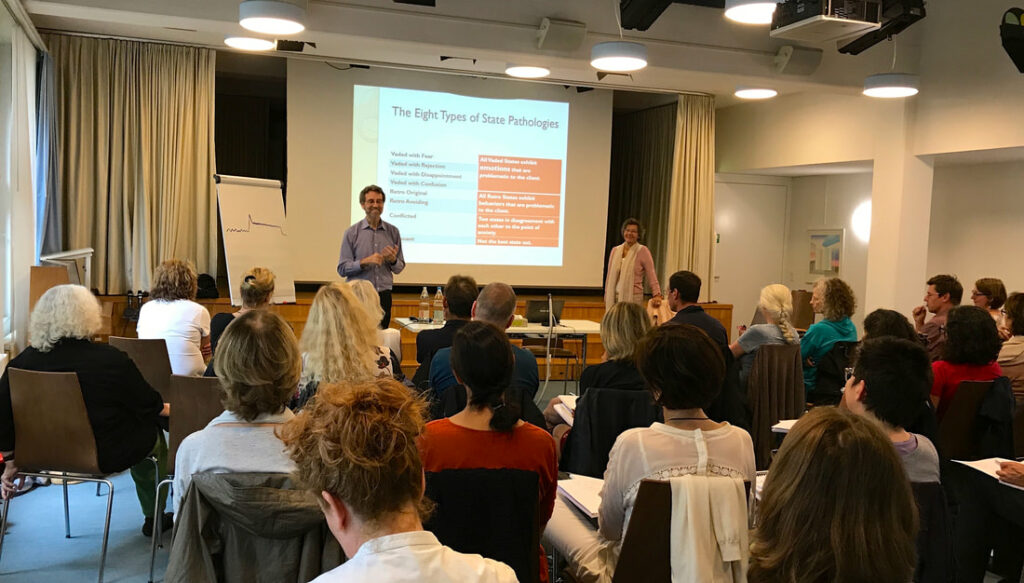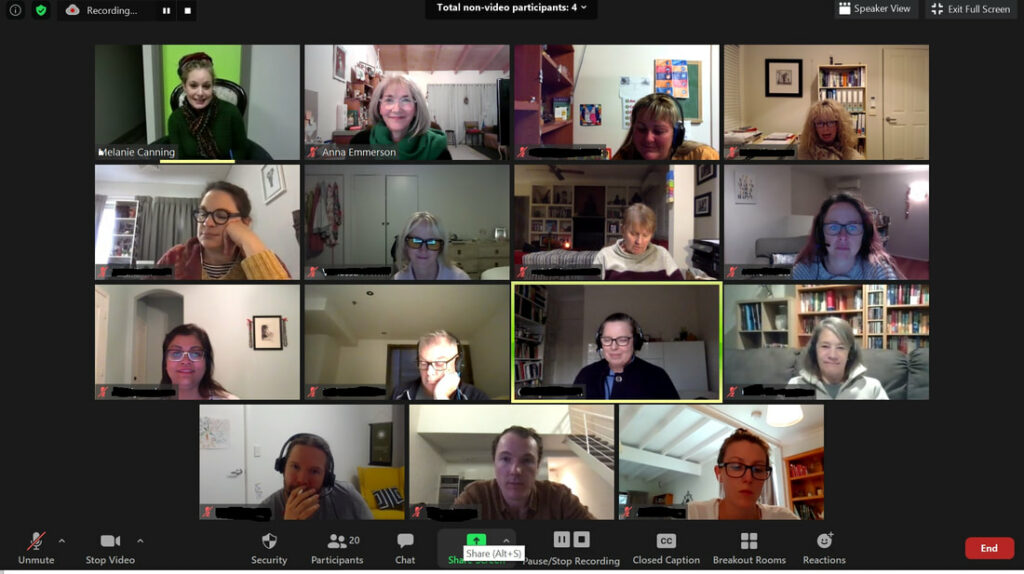The Clinical Resource Therapy training workshop provides participants with a qualification, enabling therapists to call themselves and provide services to others as an RTI accredited Clinically Qualified Resource Therapist. This training is extremely useful, both as a therapeutic tool that can bring quick and lasting change to patients and clients in need and as an astute choice in career and professional development.

Foundation and Clinical training is available in many locations around the world. More therapists and trainers are needed as more client this therapy. Full qualification training is now available online, inclusive and up to the Advanced Clinical and RT Trainer Qualification (since 2020) and continues via traditional classroom delivery (since 2014).
Clinical RT training provides participants with an accredited Clinical Qualification in Resource Therapy
Clinically Qualified Resource Therapists (CRTs) enjoy community support and resources generously shared amongst a strong and growing international network of therapists consisting of, not limited to: psychologists, medical and allied health practitioners, psychotherapists (including clinical hypnotherapists), psychiatrists, nurses, social workers, teachers, counsellors, sports and physiology coaches, life coaches, mentors and industry professional development managers.

CRT training includes presentation, discussion, demonstrations, and practice in order to prepare therapists to work with Resource States.
As participants practice they are able to benefit from immediate supervision in order to visit ways that techniques may be honed or improved.
The personality is composed of parts and those parts are our Resources. When they are in a Normal Condition there is Psychological Health. Resource States may become pathological into four general conditions.
| 1. | Vaded | These parts hold unwanted Emotions. |
| 2. | Retro | These parts do unwanted Behaviours. |
| 3. | Conflicted | These parts are in Conflict with each other. |
| 4. | Dissonant | These parts are Conscious at the wrong time. |
Resource Therapy allows therapists to respond directly to the personality part that holds the problem. Many therapies allow the patient to speak throughout therapy from an intellectual, talkative, personality part that is not directly related to the presenting issue. Because Resource Therapy attends directly to the personality part that is pathological it is quick and lasting.
RT techniques allow the therapist to learn criteria to diagnose presented issues, and once diagnosed specific RT Actions are ascribed to each diagnosis. The therapeutic process is clear and the treatment regimens are distinct.
The Clinical Training in Resource Therapy will teach, demonstrate and practice both diagnosis and treatment. Diagnostic categories and some of their associated issues are listed below.
- Vaded with Fear: (Phobias, PTSD, Panic, situational fear),
- Vaded with Rejection: (Feeling worthless or unlovable, high need for approval),
- Vaded with Confusion: (Rumination, confusion),
- Vaded with Disappointment: (Depression, Despair).
- Retro Original (Pouting, Anti-Social Behaviour, Rage, Personality Disorders, Passive Aggressive Behaviour)
- Retro Avoiding (Addictions, OCD, Withdrawal, Eating Disorders)
- Conflicted (Procrastination, Sleep Disturbance, Chronic Fatigue, Cognitive Dissonance)
- Dissonant (Frustration in Coping Ability, Below par performance)
The Clinical Training demonstrates how to assign a specific selection of RT Actions to respond to each diagnosis.
The Clinical Training includes information to understand the formation and nature of Resources, how they interact in the personality, and how best to bring them to the surface and communicate with them to affect change. Below are some of the inclusions covered during the clinical training. Questions will be entertained to include other specific techniques that participants require.
- Brief History of Resource Therapy
- Nature of Resource States, Formation, Goals of Resource State Therapy, Permanence
- Resource States vs DID Alters
- The Conscious State, Surface and Underlying States
- Normal, Vaded, Retro, Conflicted, and Dissonant States
- RT Actions (15 distinct treatment techniques)
- Introduction of Resource State Therapy to the Client
- Ways to access Resource States
- Working with Resources; Gaining confidence and facilitating state to state communication
- How to address Resource States, and how to move from one to another
- What questions to ask and what notes to keep
- Aspects of a Resource Therapy Session
- What lies within: Resource States, Inner Strength, Interjects, Other-Personalised Introjects, Creative Form Introjects
The training also includes assistance for participants to be prepared for roadblocks that some clients manifest.
Overcoming hurdles: When the client has difficulty naming a Resource, when the client has difficulty finding a Resource that can help another state, accessing the desired state,
- When the client is reluctant to speak to a Resource or an Introject in using an empty chair,
- When the client does not speak directly to the introject in the empty chair,
- Spontaneous hypnosis
- Handling Resistance in Resource Therapy,
- Dealing with difficult or destructive Resources,
- Working with abreactions
- Speaking to the introject of a perpetrator
There are four central Resource Techniques that provide interventions for most psychological issues. The clinical training provides presentation, demonstration and practice for these four methods of working.
- Helping Vaded Resource States that are holding issues from the past that interfere currently.
- Bridging from the current emotional distress to the original sensitizing issue.
- Resolving the upset states: The Expression, Introject Speak, Removal and relief method to resolve trauma.
- Helping Retro States learn positive behavior.
- Helping Conflicted Resource States resolve their conflict. Resolving Internal Dissent.
- Helping Dissonant States learn be Conscious at the right time to better perform at a high level, and enjoy living. (Working with clients with a situational concern not based in a past issue.)
The Clinical Training also includes specific Resource techniques to help clients deal with a range of presentations.
· Addictions: gambling, drugs, workaholism, obsessive compulsive disorder, and others. Techniques for reduction of non-addictive habit behavior.
- Depression
- Panic disorder and PTSD
- Couples counseling: Relationship issues
- Complicated Bereavement: Working with grief and loss, past loss and future loss
- Eating Disorders (Anorexia and Bulimia)
- Psychosomatic Physiology
- Pain Control
- Suicidal ideation
- Anorexia and Bulimia
- Anger issues
- Promoting Self Awareness and Knowledge of Strengths (self esteem).
The training also includes advanced training skills that will help the therapist better work with Resources:
- Helping Resources keep their purpose to help, but learn to accomplish that purpose in a way that is helpful to the client.
- Resource assessment: assessing the problem, not the person, to know which direction to take in therapy.
- Practice issues, getting clients, referrals.
- Supporting skills and ethical considerations.
- The value and practice of advanced listening.
- Learning to make sure the client’s central problem is the focus.
The Clinical Training in Resource Therapy is designed and presented to meet the needs of participants. That is, the presentation will vary in speed of delivery and detail to topic according to the particular group. Dr Emmerson authored most of the techniques that are presented, therefore depth of coverage can respond directly to the needs of the group.
